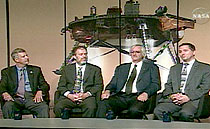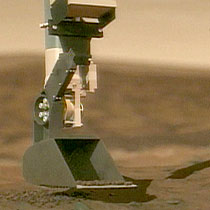2007年VOA标准英语-Phoenix Probe Ready for Mars Mission(在线收听)
By Paul Sisco
Washington
13 July 2007
NASA scientists have unveiled details of the space agency's plans to pierce the icy surface of Mars, near its north pole. The mission is designed to find evidence of water or life on the red planet. VOA's Paul Sisco reports.
 |
| NASA scientists described the Phoenix mission to Mars |
The probe is scheduled for launch in the predawn hours of August third and will take 10 months to reach its target.
Project Manager Barry Goldstein explains what happens next. "On May 25th, 2008 the fun begins. We separate from the crew stage. We're traveling at about 12,600 miles an hour. We take up most of that energy with the heat shield, which is at the bottom the entry vehicle. We take up about 94 percent of the energy as we come in. We drop a parachute."
 |
| An artist's drawing of the probe making its landing on Mars |
Goldstein further explains, "Basically what we are dealing with is, we're dealing with a system that is coming into the planet at 12,600 miles an hour, screaming into the planet and slowing down to basically zero inside seven minutes."
Once the dust settles the solar arrays on the Phoenix deploy. The camera springs up into place, followed by instruments used to collect atmospheric data. The robotic arm on Phoenix scoops up soil samples and drops them into a sort of oven for analysis.
That is done by remote by Peter Smith's team at the University of Arizona.
 |
| Phoenix's robotic arm |
The public is invited to join the Phoenix mission in its search for water and life on Mars by logging onto the Internet at http://www.NASA.gov